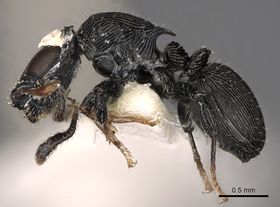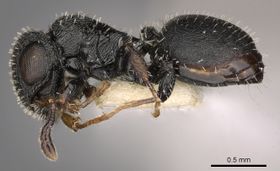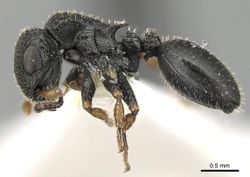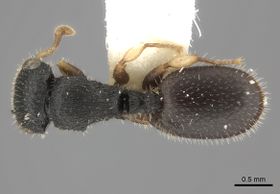Key to Afrotropical Cataulacus Species
The key below is based on Bolton's key of the Afrotropical Cataulacus species from: Bolton, B. 1982. Afrotropical species of the myrmicine ant genera Cardiocondyla, Leptothorax, Melissotarsus, Messor and Cataulacus (Formicidae). Bulletin of the British Museum (Natural History) Entomology. 45:307-370.
Notes in cursive in brackets are modifications or explanations to original keys
This key covers all the Afrtropical species except Cataulacus voeltzkowi, cited from Comoros
You may also be interested in:
- Key to Cataulacus of the Indo-Australian and Oriental Regions
- Key to Cataulacus of the Malagasy Region
- Cataulacus
AFT-1
- Dorsal alitrunk without standing hairs of any description or at most with only 1-2 very short hairs at the highest point of the pronotum1. Generally hairs absent from alitrunk but rarely2 sparse strongly appressed hairs may be present.. . . . . AFT-2
1 Some species (as in Cataulacus pullus) may present very sparse short setae at pronotal margins and highest point of the pronotum. These are never abundant and the overall aspect is glabrous
2 only in one species: Cataulacus adpressus
- Dorsal alitrunk with numerous standing hairs which are usually conspicuous. If the standing hairs are very short they are more or less evenly distributed over the dorsum and are not restricted to the highest point of the pronotum . . . . . AFT-10
AFT-2
return to couplet #AFT-1
- Propodeum completely unarmed, without trace of spines or teeth. (Zaire) . . . . . Cataulacus inermis
 Cataulacus inermis worker |
 Cataulacus inermis worker |
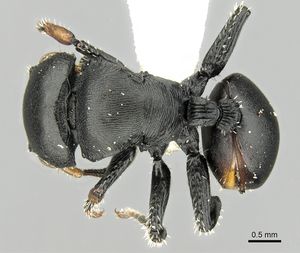 Cataulacus inermis worker |
- Propodeum armed with a pair of spines or teeth . . . . . AFT-3
AFT-3
return to couplet #AFT-2
- Dorsal alitrunk strongly sulcate throughout. Appressed hairs present on the dorsal alitrunk (Ghana) . . . . . Cataulacus adpressus
 Cataulacus adpressus worker |
 Cataulacus adpressus worker |
 Cataulacus adpressus worker |
- Dorsal alitrunk reticulate-punctate to reticulate, usually also with fine rugulae or a rugoreticulum present; never sulcate. Appressed hairs absent from dorsal alitrunk . . . . . AFT-4
AFT-4
return to couplet #AFT-3
- Petiole dorsally strongly transversely rugose or sulcate everywhere . . . . . AFT-5
- Petiole dorsally variously sculptured but never transversely strongly rugose or sulcate . . . . . AFT-7
AFT-5
return to couplet #AFT-4
- First gastral sternite laterobasally with a longitudinal margination or carina which parallels the laterobasal margination of the first tergite. Femora of hind legs not excessively anteroposteriorly compressed . . . . . AFT-6
- First gastral sternite laterobasally without a longitudinal margination or carina which parallels the laterobasal margination of the first tergite. Femora of hind legs strikingly anteroposteriorly compressed, narrow and very deep. (Sierra Leone, Cameroun, Equatorial Guinea, Congo, Zaire, Uganda) . . . . . Cataulacus kohli
 Cataulacus kohli worker |
 Cataulacus kohli worker |
 Cataulacus kohli worker |
AFT-6
return to couplet #AFT-5
- Sides of head behind eyes irregular, either denticulate, crenulate or otherwise jagged. Relatively broader-headed species, CI > 125, the head strongly broadened behind the eyes. Laterally projecting hairs on sides of head behind eyes long and conspicuous. (Sierra Leone, Ghana, Nigeria, Cameroun, Uganda, Zaire, Zambia) . . . . . Cataulacus huberi
 Cataulacus huberi worker |
 Cataulacus huberi worker |
 Cataulacus huberi worker |
- Sides of head behind eyes regular, smooth, neither denticulate nor crenulate. Relatively narrower-headed species, CI 120 or less, the head not strongly broadened behind the eyes. Laterally projecting hairs on sides of head behind eyes minute and inconspicuous or absent. (Ghana, Nigeria, Cameroun, Uganda, Congo, Zaire) . . . . . Cataulacus egenus
 Cataulacus egenus worker |
AFT-7
return to couplet #AFT-4
- Petiole and postpetiole in dorsal view strongly longitudinally sulcate. Postpetiole dorsally divided into two projecting lobes by a deep median longitudinal cleft. (Cameroun, Zaire) . . . . . Cataulacus lobatus
 Cataulacus lobatus worker |
 Cataulacus lobatus worker |
 Cataulacus lobatus worker |
- Petiole and postpetiole in dorsal view not strongly longitudinally sulcate. Postpetiole dorsally not divided into two projecting lobes by a deep median longitudinal cleft . . . . . AFT-8
AFT-8
return to couplet #AFT-7
- Lateral pronotal margination with 2 teeth. Dorsal and lateral surfaces of petiole and postpetiole with numerous tubercles and small angular prominences, presenting a multi-peaked and irregular surface. (Cameroun, Congo, Zaire, Kenya) . . . . . Cataulacus pullus
 Cataulacus pullus worker |
 Cataulacus pullus worker |
 Cataulacus pullus worker |
- Lateral pronotal margination with 0-1 teeth. Dorsal and lateral surfaces of petiole and postpetiole not equipped with tubercles and small angular prominences . . . . . AFT-9
AFT-9
return to couplet #AFT-8
- With the head in full-face view the lateral margins behind the eyes without a row of short projecting hairs. Lateral pronotal margination without teeth. (Ghana, Cameroun, Guinea, Zaire) . . . . . Cataulacus tardus
 Cataulacus tardus worker |
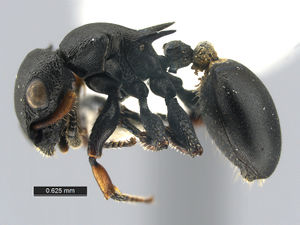 Cataulacus tardus worker |
 Cataulacus tardus worker |
- With the head in full-face view the lateral margins behind the eyes with a row of short projecting hairs. Lateral pronotal margination with a single tooth on each side, close to the anterior pronotal corner. (Zaire) . . . . . Cataulacus theobromicola
AFT-10
return to couplet #AFT-1
- Petiole and postpetiole strongly transverse, much flattened dorsoventrally and without nodes, both very broadly thickly V-shaped in dorsal view. Propodeum armed only with a pair of small teeth or tubercles which are inconspicuous. (Sierra Leone, Liberia, Ghana, Nigeria, Cameroun, Zaire) . . . . . Cataulacus mocquerysi
 Cataulacus mocquerysi worker |
 Cataulacus mocquerysi worker |
 Cataulacus mocquerysi worker |
- Petiole and postpetiole nodiform, not strongly transverse nor flattened, not broadly V-shaped in dorsal view. Propodeal spines well developed and conspicuous . . . . . AFT-11
AFT-11
return to couplet #AFT-10
- Hairs on clypeus and usually also on remainder of cephalic dorsum bizarre, strongly clavate or stalked-suborbicular. In most the apex of each hair is very strongly swollen whilst the stem is narrow; sometimes the stem may be short or very short . . . . . AFT-12
- Hairs on clypeus and remainder of cephalic dorsum simple, usually stout cylindrical and blunt but sometimes very short and stubble-like, sometimes elongate and fine and occasionally gradually increased in thickness from base to apex, but not strongly clavate or stalked-suborbicular . . . . . AFT-20
AFT-12
return to couplet #AFT-11
- With the alitrunk in dorsal view the pronotal margin on each side without an unbroken series of denticles which project laterally between the pronotal corner and the site of the promesonotal junction . . . . . AFT-13
- With the alitrunk in dorsal view the pronotal margin on each side with an unbroken series of denticles which project laterally between the pronotal corner and the site of the promesonotal junction . . . . . AFT-15
AFT-13
return to couplet #AFT-12
- First gastral tergite regularly longitudinally sulcate throughout. (Cameroun) . . . . . Cataulacus jacksoni
- First gastral tergite reticulate-punctate or with fine rugulae overlying reticulate-punctate ground-sculpture, never longitudinally sulcate . . . . . AFT-14
AFT-14
return to couplet #AFT-13
- Propodeal dorsum longitudinally rugulose. (Nigeria, Cameroun) . . . . . Cataulacus vorticus
 Cataulacus vorticus worker |
 Cataulacus vorticus worker |
 Cataulacus vorticus worker |
- Propodeal dorsum transversely rugose. (Nigeria) . . . . . Cataulacus boltoni
AFT-15
return to couplet #AFT-12
- Bizarre hairs on dorsum of head behind clypeus with a very short basal stem, appearing stud-like, the swollen apices set very close to the cephalic surface . . . . . AFT-16
- Bizarre hairs on dorsum of head behind clypeus with an elongate basal stem, never short and stud-like, the swollen apices conspicuously raised well clear of the cephalic surface . . . . . AFT-17
AFT-16
return to couplet #AFT-15
- Larger species, HW 0.80 or more. (Tanzania, Zimbabwe, Angola, South Africa) . . . . . Cataulacus brevisetosus
 Cataulacus brevisetosus worker |
 Cataulacus brevisetosus worker |
 Cataulacus brevisetosus worker |
- Smaller species, HW < 0.80. (Ivory Coast, Ghana, Cameroun, Uganda, Kenya, Tanzania, Angola, Mozambique) . . . . . Cataulacus jeanneli
 Cataulacus jeanneli worker |
 Cataulacus jeanneli worker |
 Cataulacus jeanneli worker |
AFT-17
return to couplet #AFT-15
- Dorsal alitrunk with weak rugulose sculpture and a blanketing dense reticulate-punctate ground-sculpture which is very conspicuous between the rugulae, the surface matt and dull . . . . . AFT-18
- Dorsal alitrunk with strong dense rugose sculpture the spaces between which are unsculptured or at most contain some feeble superficial ground-sculpture, the surface glossy . . . . . AFT-19
AFT-18
return to couplet #AFT-17
- Denticles on lateral pronotal margins minute and inconspicuous in dorsal view, much smaller than the tooth at the pronotal corner. (Cameroun) . . . . . Cataulacus satrap
- Denticles on lateral pronotal margins large and conspicuous, at least as large as the tooth at the pronotal corner, sometimes larger. (Ghana, Nigeria, Cameroun, Zaire) . . . . . Cataulacus lujae
 Cataulacus lujae worker |
AFT-19
return to couplet #AFT-17
- Smaller species, HW 0.80 or less. Body hairs relatively short (Fig. 34). Basal quarter of first gastral tergite without strong rugulae, either punctate or with feeble rugulae caused by alignment of punctures. Propodeal spines in profile evenly feebly curved. (Ghana, Nigeria) . . . . . Cataulacus moloch
- Larger species, HW > 0.90. Body hairs relatively long (Fig. 33). Basal quarter of first gastral tergite with strong longitudinal rugulae which are independent of the underlying puncturation. Propodeal spines in profile with basal third elevated and apical two-thirds recurved. (Cameroun) . . . . . Cataulacus centrurus
AFT-20
return to couplet #AFT-11
- Erect hairs on dorsal surfaces of head, alitrunk and gaster abundant, dense, very long narrow and fine, curved or even sinuate, the entire ant with a softly pilose appearance rather than the bristly appearance usually associated with this genus . . . . . AFT-21
- Erect hairs on dorsal surfaces of head, alitrunk and gaster relatively sparse, short broad and blunt, coarse and usually straight, the entire ant with a bristly or stubbly appearance . . . . . AFT-22
AFT-21
return to couplet #AFT-20
- Propodeal dorsum longitudinally rugulose or rugose. Larger species, HL > 0.90, HW > 0.85. (Ghana, Cameroun, Angola) . . . . . Cataulacus elongatus
 Cataulacus elongatus worker |
 Cataulacus elongatus worker |
 Cataulacus elongatus worker |
- Propodeal dorsum transversely rugulose. Smaller species, HL < 0.90, HW < 0.85. (Zaire) . . . . . Cataulacus pilosus
 Cataulacus pilosus worker |
 Cataulacus pilosus worker |
 Cataulacus pilosus worker |
AFT-22
return to couplet #AFT-20
- Head relatively broad or very broad, the eyes small, CI > 112, OI < 30. In dorsal view the posterolateral portion of the pronotal margin produced into a large spine or triangular prominence. Propodeal spines long and very strong, not dorsoventrally flattened . . . . . AFT-23
- Head relatively narrow and eyes larger, CI 110 or less, OI > 32. In dorsal view the posterolateral portion of the pronotal margin usually armed with a short tooth or a denticle. When a short tooth is present in this position it is usually comparable in size with others on the pronotal margin. Propodeal spines usually dorsoventrally flattened, only rarely otherwise . . . . . AFT-24
AFT-23
return to couplet #AFT-22
- Sculpture of dorsal alitrunk a very distinct rugoreticulum with strongly reticulate-punctate interspaces. Lateral margins of mesonotum usually with one or more denticles. (Liberia, Ghana, Cameroun, Equatorial Guinea, Gabon, Congo, Zaire) . . . . . Cataulacus erinaceus
 Cataulacus erinaceus worker |
 Cataulacus erinaceus worker |
 Cataulacus erinaceus worker |
- Sculpture of dorsal alitrunk variable in intensity but consisting essentially of a longitudinal rugation or sulcation which may be irregular or sinuate. Lateral margins of mesonotum usually without denticles. (Ivory Coast, Liberia, Ghana, Nigeria, Cameroun, Equatorial Guinea, Zaire, Uganda) . . . . . Cataulacus guineensis
 Cataulacus guineensis worker |
 Cataulacus guineensis worker |
 Cataulacus guineensis worker |
AFT-24
return to couplet #AFT-22
- Posterior one-quarter of first gastral tergite coarsely longitudinally sulcate, rugose or striate, this sculpture always very distinct and usually extending to the apex of the tergite . . . . . AFT-25
- Posterior one-quarter of first gastral tergite reticulate-punctate or finely superficially sculptured and shining; a few fine scattered longitudinal rugulae formed by the fusion of the margins of aligned punctures may sometimes be present . . . . . AFT-27
AFT-25
return to couplet #AFT-24
- Smaller species, HW < 0.90, with relatively large eyes, OI 50 or more. (Zaire, Kenya) . . . . . Cataulacus striativentris
 Cataulacus striativentris worker |
- Larger species, HW > 0.95, with relatively smaller eyes, OI in range 34-48 . . . . . AFT-26
AFT-26
return to couplet #AFT-25
- Dorsal surfaces of head and alitrunk with numerous conspicuous relatively long stout hairs. Eyes slightly larger, OI range 43-48. (Kenya, Mozambique, South Africa) . . . . . Cataulacus wissmannii
 Cataulacus wissmannii worker |
 Cataulacus wissmannii worker |
 Cataulacus wissmannii worker |
- Dorsal surfaces of head and alitrunk with relatively few inconspicuous very short stubbly hairs. Eyes slightly smaller, OI range 34-40. (Ethiopia, Somali Republic, Kenya, Tanzania, Zambia, Malawi, Zimbabwe, Mozambique, Angola, South West Africa, South Africa) . . . . . Cataulacus intrudens
 Cataulacus intrudens worker |
 Cataulacus intrudens worker |
 Cataulacus intrudens worker |
AFT-27
return to couplet #AFT-24
- Occiput with a distinct deeply incised transverse groove above the foramen. Below this the remaining strip of the occiput juts out as a shield over the dorsal rim of the foramen itself. Propodeum below the plane of the promesonotum (Uganda) . . . . . Cataulacus impressus
- Occiput without a deeply incised transverse groove above the foramen Propodeum at the same level of the promesonotum . . . . . AFT-28
AFT-28
return to couplet #AFT-27
- Subpetiolar process complex, anteroventrally with a prominent broadly rounded angle and posteroventrally with an extended heel or spur; the surface between these two usually concave. Postpetiole with a strongly developed simple long digitiform ventral process . . . . . AFT-29
- Either the subpetiolar process simple, a rectangular or subrectangular lobe without the above configuration or with a feebly prominent acute angle or small tooth posteroventrally; if the latter then the postpetiole with a short blunt or short tooth-like ventral process . . . . . AFT-35
AFT-29
return to couplet #AFT-28
- Eyes relatively small, OI < 50 . . . . . AFT-30
- Eyes relatively large, OI 50 or more . . . . . AFT-32
AFT-30
return to couplet #AFT-29
- Propodeal spines long, 0.40 or more in profile (in HW range 1.10-1.26), strongly divergent and markedly elevated; in profile the spines distinctly longer than the maximum length of the petiole. (Cameroun, Zaire) . . . . . Cataulacus greggi
 Cataulacus greggi worker |
 Cataulacus greggi worker |
 Cataulacus greggi worker |
- Propodeal spines short, < 0.25 in profile (in HW range 0.90-1.04), not strongly divergent nor markedly elevated; in profile the spines distinctly shorter than the maximum length of the petiole . . . . . AFT-31
AFT-31
return to couplet #AFT-30
- Stout hairs on cephalic dorsum extremely dense, appearing as a bristly pelt in profile. A line across the dorsum at the midlength of the eyes with many more than 10 hairs. Hairs on dorsum of head more or less cylindrical, not spatulate; the hairs truncated apically, their sides more or less straight and parallel. (Zaire) . . . . . Cataulacus cestus
- Stout hairs on cephalic dorsum sparse, not giving the appearance of a bristly pelt in profile. A line across the dorsum at the midlength of the eyes with at most 10 hairs. Hairs on dorsum of head conspicuously spatulate, broadly convex apically, their sides shallowly convex and convergent basally. (Kenya) . . . . . Cataulacus kenyensis
AFT-32
return to couplet #AFT-29
- Most or all of stout hairs on clypeus and dorsum of head increasing markedly in thickness from base to apex, frequently 2-3 times broader at apex than at base. (Sierra Leone, Ghana, Cameroun, Chad, Zaire) . . . . . Cataulacus pygmaeus
 Cataulacus pygmaeus worker |
 Cataulacus pygmaeus worker |
 Cataulacus pygmaeus worker |
- Most or all of stout hairs on clypeus and dorsum of head cylindrical or nearly so, not increasing markedly in thickness from base to apex; in some cases the hairs may broaden approximately to their midlength and then continue at that width to their apices . . . . . AFT-33
AFT-33
return to couplet #AFT-32
- Mesonotal and propodeal dorsa with very fine superficial low irregular weak wandering rugulae, feeble or faded out in places but never evenly spaced nor regularly longitudinal. Spaces between these fine rugulae densely strongly reticulate-puntate and dull. (Ghana, Congo, Zaire) . . . . . Cataulacus weissi
 Cataulacus weissi worker |
 Cataulacus weissi worker |
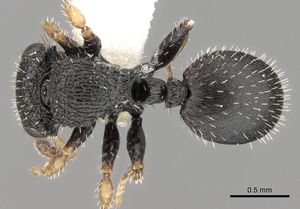 Cataulacus weissi worker |
- Mesonotal and propodeal dorsa with conspicuous strong broad longitudinal rugae which may be parallel but which are never faded out in places. Spaces between the rugae weakly superficially sculptured or unsculptured, the surfaces shining . . . . . AFT-34
AFT-34
return to couplet #AFT-33
- Entire body exceptionally highly polished and very shiny. Longitudinal rugae on posterior half of mesonotum and on propodeum very broad, subsulcate and parallel, without anastomoses on the prodpodeum. (Nigeria) . . . . . Cataulacus taylori
- Dully shining, not obviously highly polished. Longitudinal rugae on posterior half of mesonotum and on propodeum not subsulcate, not parallel, tending instead to diverge and converge slightly along their lengths or to be weakly wavy; on the propodeum with anastomoses. (Benin Republic) . . . . . Cataulacus difficilis
 Cataulacus difficilis worker |
 Cataulacus difficilis worker |
 Cataulacus difficilis worker |
AFT-35
return to couplet #AFT-28
- Hairs on dorsum of head exceptionally short, forming only a minute stubble on the surface. Dorsum of head usually meeting occipital surface in a marked angle or edge, the one not rounding evenly into the other . . . . . AFT-36
- Hairs on dorsum of head conspicuous and quite dense, not represented only by a minute stubble on the surface. Dorsum of head rounding into occipital surface . . . . . AFT-37
AFT-36
return to couplet #AFT-35
- Tooth on mesokatepisternum large, long and acute, projecting anteriorly and usually clearly visible in dorsal view, projecting beyond the margins of the mesonotum. (South Africa) . . . . . Cataulacus micans
- Tooth on mesokatepisternum small and short, usually a mere denticle or acute angle, sometimes not even as strong as this; not visible in dorsal view. (Ethiopia, Somali Republic, Kenya, Tanzania, Malawi, Zimbabwe, Mozambique, Angola, South West Africa, South Africa) . . . . . Cataulacus intrudens
 Cataulacus intrudens worker |
 Cataulacus intrudens worker |
 Cataulacus intrudens worker |
AFT-37
return to couplet #AFT-35
- Larger species, HW > 1.10, PW > 0.90. (Zaire) . . . . . Cataulacus bequaerti
- Smaller species, HW < 1.10, PW < 0.90 . . . . . AFT-38
AFT-38
return to couplet #AFT-37
- Pronotum laterally with a number of irregular rounded tuberculiform projections, without a regular series of denticles although some of the projections appear to consist of 2 or more denticles fused together. (South Africa) . . . . . Cataulacus fricatidorsus
- Pronotum laterally with a more or less regularly spaced series of denticles . . . . . AFT-39
AFT-39
return to couplet #AFT-38
- Dorsal surfaces of mesonotum and propodeum extremely finely and very densely more or less evenly longitudinally rugulose, the rugulae so close together that the spaces between them are wide enough for only 1-2 rows of punctures. (Cameroun) . . . . . Cataulacus mckeyi
- Dorsal surfaces of mesonotum and propodeum coarsely rugose, the rugae predominantly longitudinal but with some strong cross-meshes, breaks or irregularities. The rugae widely spaced so that the spaces between most of them accommodate many more than 2 rows of punctures. (Ghana, Nigeria, Cameroun, Zaire, Sudan, Uganda, Tanzania, South Africa) . . . . . Cataulacus traegaordhi



